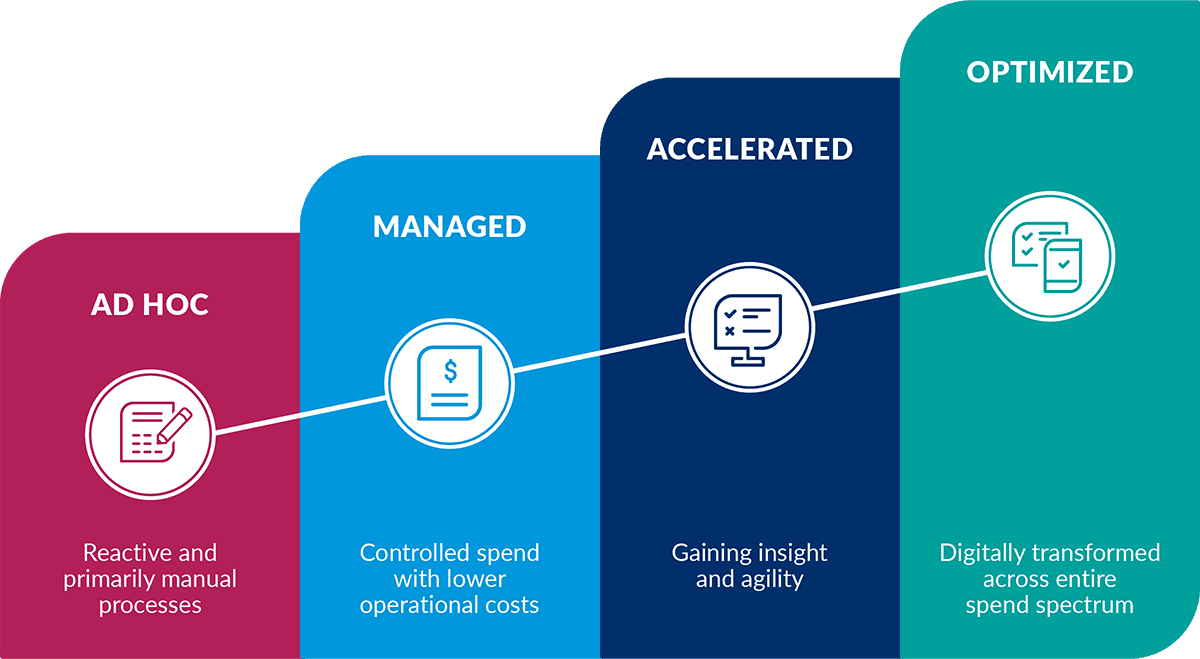One of the misconceptions about digitizing and optimizing financial processes is that it’s binary. Either (a) your organization is still using spreadsheets, and lots of human-powered processes, in which case it’s time to switch to a software solution, or (b) you’ve moved to a software solution to manage them, so you’re all set.
But it’s far more nuanced than that, and so are the implications for your finance team. Switching from primarily manual processing to a software solution that can automate basic processes is certainly a move in the right direction. However it’s really just the first step on a journey to advance from many disparate paper-based processes to an integrated, fully-automated solution, which eliminates fraud and waste, while optimizing spend and helping manage cash flow.
So what does spend optimization actually mean in a real-world situation? It means that as a team you have far more control over all aspects of your organization’s spend, whether it’s an employee’s morning coffee and a muffin, or the rent for your offices You’ll know what’s been spent, what cash outflows you can anticipate - and when and how you need to pay - and you can make sure that all of this adheres to your organization’s policy.
It’s also about making your spend really count and work for you. Are your employees taking advantage of corporate discounts with airlines and hotels? Are you able to process invoices quickly enough to leverage your vendors’ early payment discounts? How much spend can you shift to virtual cards, so you can benefit from cash back rebates?
Although you may have moved past the old way of doing things, here are some ways that you could take managing your spend to the next level (and beyond).

Employee expenses
- The old way: Mainly manual, with some use of technology, such as scanning and emailing receipts for approval.
- The first step: Deploy an expense automation solution for capturing and processing employee spend information.
- Fully optimized: A fully automated, near-real-time experience from purchase to reimbursement.
Travel booking
- The old way: Employees book their own travel on consumer sites with little oversight.
- The first step: Use a travel management company/booking tool that enforces travel policy.
- Fully optimized: A holistic approach to capturing, analyzing and controlling travel spend, that uses travel data to negotiate with vendors.
Invoices
- The old way: Mainly manual, with some use of technology, such as scanning and emailing invoices for approval.
- The first step: Leverage an AP automation solution with OCR technology for submitting and approving invoices online.
- Fully optimized: Fully automated process, from remittance to reconciliation, with a complete view of all invoices.
Payments
- The old way: Check runs, with paper checks manually sent through the mail
- The first step: Moving payments from check to ACH, eliminating the need for manual check runs
- Fully optimized: Full control over payment timing, using virtual cards to take advantage of discounts and rebates.
Spend compliance
- The old way: Vague policies that are arbitrary and hard to enforce.
- The first step: Configuring spend policies into the expense and AP automation solutions.
- Fully optimized: Built-in machine learning capability with targeted review by independent auditors, to eliminate all out-of-policy spend.
Insight
- The old way: Siloed data trapped in disparate systems, making manual analysis cumbersome and inaccurate.
- The first step: Basic report creation with limited high-level analytics dashboard capabilities.
- Fully optimized: Tailored analytics capabilities, enabling strategic decision-making based on data versus intuition.
While optimizing spend is certainly a technology-based initiative, it also means a change in the way companies look at the spend management function. It requires taking a more strategic and holistic solution-based approach. This involves change management within the organization to fully implement these capabilities and educate teams on spend optimization, as well as reviewing and refreshing processes on a regular basis.
The long-term benefits of making spend optimization a cornerstone of the organization’s finance can be significant, whether it’s more productive teams, lower costs, better compliance, or an improved financial position.
If you’d like to learn more about Emburse’s Spend Optimization Model and how it could benefit your organization, contact Emburse for a free assessment of your organization spend optimization maturity and help mapping out your journey to a stronger financial posture.
